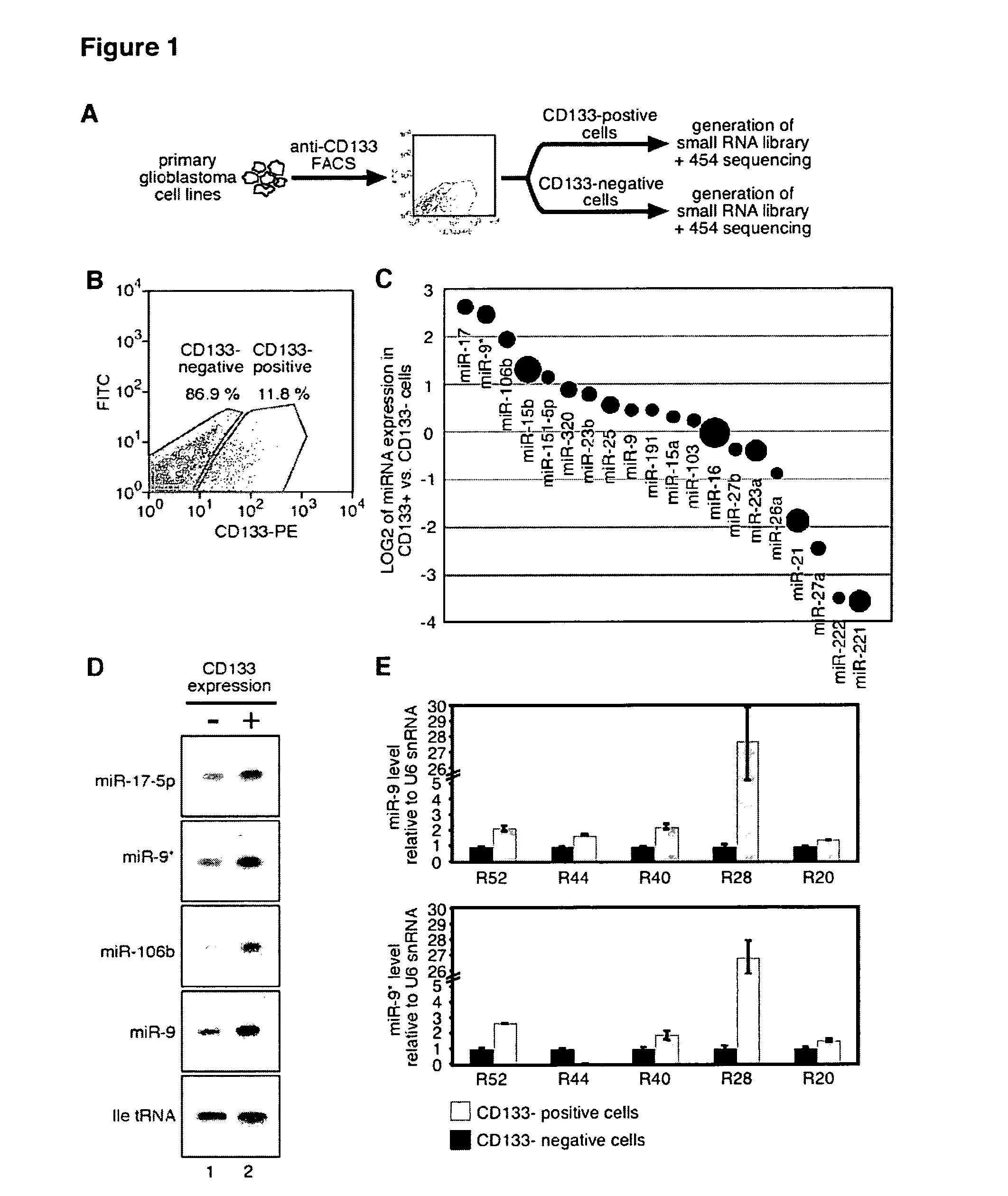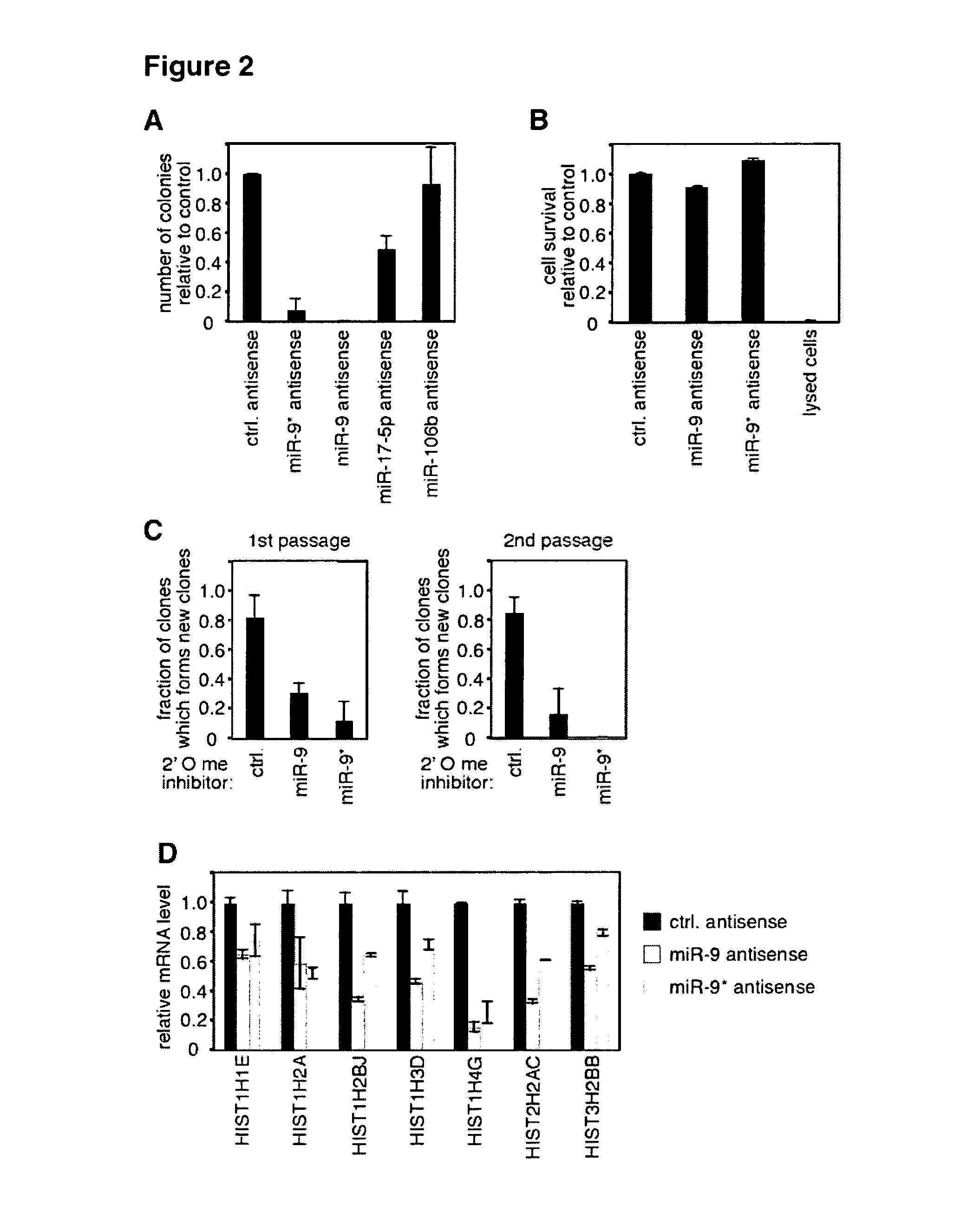Compositions and methods for micro-rna expression profiling of cancer stem cells
a cancer stem cell and expression profiling technology, applied in the field of compositions and methods for microrna (mirna) expression profiling of cancer stem cells, can solve the problems of inability to find suitable approaches to eliminate cancer, cancer still remains a major cause of death worldwide, and the expansion of malignant tissu
- Summary
- Abstract
- Description
- Claims
- Application Information
AI Technical Summary
Benefits of technology
Problems solved by technology
Method used
Image
Examples
example 1
Materials and Methods
1.1. Cell Culture
[0184]The generation of R11, R20, R28, R40, R44, and R52 cell lines from glioblastoma samples was performed as previously described (Beier, D. et al. (2007) Cancer Res. 67, 4010-4015).
1.2. Antibodies
[0185]The following antibodies were used: mouse anti-Tuj1 MMS-435p (from Covance), mouse anti-β-actin AC15 (from Abcam), rabbit anti-GFAP (from DAKO), anti-CD133-2 293C3-PE (from Miltenyi), anti-rabbit-HRP, anti-mouse-HRP (both from Sigma).
1.3. Oligonucleotides
[0186]2′O methyl oligonucleotides were chemically synthesized using RNA phosphoramidites (from Pierce) on a Äkta Oligopilot 10 DNA / RNA synthesizer (from GE healthcare), according to the manufacturer's protocol. The sequences were as follows:
hsa-miR-9* antisense:5′-ACUUUCGGUUAUCUAGCUUUAdThsa-miR-17-5p antisense:5′-ACUACCUGCACUGUAAGCACUUUGdThsa-miR-106b antisense:5′-AUCUGCACUGUCAGCACUUUAdThsa-miR-9 antisense:5′-UCAUACAGCUAGAUAACCAAAGAdThsa-miR-122 antisense:5′-ACAAACACCAUUGUCACACUCCAdTIle tRNA pr...
example 2
miRNA Expression Profiles of CD133+ and CD133− Glioblastoma Cells
2.1. Sorting / Separation of CD133+ and CD133− Glioblastoma Cell Fractions
[0206]FIG. 1(A) schematically illustrates the experimental protocol employed for cell sorting. Primary human glioblastoma cell lines were incubated with ananti-CD133-phycoerythrin (PE) antibody and separated by fluorescence-assisted cell sorting (FACS) into CD133-positive and CD133-negative cell fractions. Subsequently, RNA was isolated and used to generate small RNA libraries, followed by 454 pyro-sequencing. A typical FACS profile of the primary glioblastoma cell line R11 is shown in FIG. 1(B). The dot-plot shows CD133-PE fluorescence on the x-axis and fluorescein isothiocyanate (FITC) on the y-axis as a control for auto-fluorescence. The regions indicate CD133-negative and CD133-positive cells, respectively. The CD133-positive (CD133+) and CD133-negative (CD133−) cell fractions were determined to be 11.8% and 86.9%, respectively.
[0207]Flow cytom...
example 3
Inhibition of hsa-miR-9 and hsa-miR-9* Expression Impairs Self-Renewal and Proliferation of Human Glioblastoma Cells
3.1. Effect on Cell Number / Cell Survival
[0212]R11 cells were transfected twice with antagomirs (based on the antisense oligonucleotides described in section 1.3. above) and seeded to 48 well plates. Neurosphere-like colonies were counted 4 weeks after transfection. Transfection with hsa-miR-9 antisense completely blocked the formation of colonies, whereas transfection with hsa-miR-9* antisense resulted only in the formation of very few colonies. Transfection with hsa-miR-17-5p antisense and hsa-miR-106b resulted in less cell colonies than in the control, but the extent was much lower than with the other antagomirs (FIG. 2(A)).
[0213]In order to analyze the selectivity of the above results, cell survival rates were determined (FIG. 2(B)). R11 cells were transfected twice with antagomirs as described above (cf. section 1.15), and cell survival was assessed via measuring l...
PUM
| Property | Measurement | Unit |
|---|---|---|
| median survival time | aaaaa | aaaaa |
| median survival time | aaaaa | aaaaa |
| nucleic acid expression | aaaaa | aaaaa |
Abstract
Description
Claims
Application Information
 Login to View More
Login to View More - R&D
- Intellectual Property
- Life Sciences
- Materials
- Tech Scout
- Unparalleled Data Quality
- Higher Quality Content
- 60% Fewer Hallucinations
Browse by: Latest US Patents, China's latest patents, Technical Efficacy Thesaurus, Application Domain, Technology Topic, Popular Technical Reports.
© 2025 PatSnap. All rights reserved.Legal|Privacy policy|Modern Slavery Act Transparency Statement|Sitemap|About US| Contact US: help@patsnap.com



